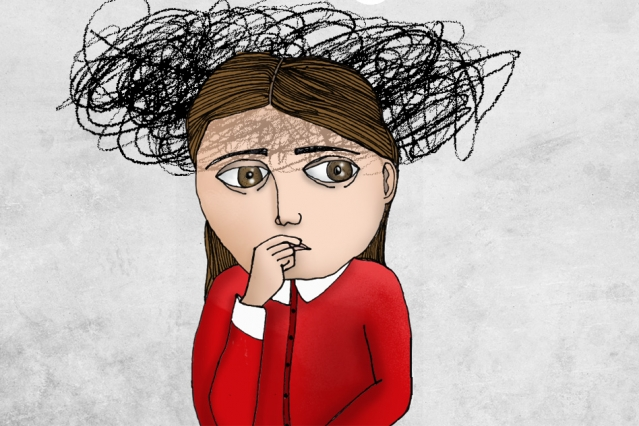The past few months have proven two things for me – first, stress causes writer’s block – I haven’t written anything lately because of the stress. And secondly, today’s middle school girls are definitely NOT okay.
Our girl had, until recently, been in a @1,500 student middle school and when she started there, she seemed okay. When she headed into middle school in August 2022, she was excited about new challenges – couldn’t wait to take Chinese class, start a debate club, and find new friends to mix in with her old friend crowd.
 She got herself up each morning at 6 am, packed her own lunch, and raced out the door to school – wanting to get there early for some friend time before school started. And after school was more friend time both off and on devices. While we laid down ground rules around when she needed to be home, schoolwork completion, device use, and keeping in touch, I was in awe of her desire for independence, yet I was missing her. But I knew it was normal for a girl her age to want to hang with the ‘tribe’ rather than her parents.
She got herself up each morning at 6 am, packed her own lunch, and raced out the door to school – wanting to get there early for some friend time before school started. And after school was more friend time both off and on devices. While we laid down ground rules around when she needed to be home, schoolwork completion, device use, and keeping in touch, I was in awe of her desire for independence, yet I was missing her. But I knew it was normal for a girl her age to want to hang with the ‘tribe’ rather than her parents.
Halfway through that school year though, things began to change. The head-whipping repetitive dynamic of dear friends declaring they no longer want to be her friend, seeking to have other friends shun her then doing an about face days later, lifting the fog of meanness and restoring normalcy was beginning to take its toll on her. Her emotional swings were wild, even by tween / teen girl standards.
 But she seemed to rebound each time and I thought, she’s going to be okay – this is just a middle school girl phase.
But she seemed to rebound each time and I thought, she’s going to be okay – this is just a middle school girl phase.
Then the physical threats at school started.
Girls really wanted to fight other girls and other students wanted to video tape and post the fights. Our girl was targeted and feigned sickness then admitted she was scared to go to school. But she didn’t want to let those threatening her force her out, so she started jujitsu lessons and the resulting empowerment seemed to make a difference. I thought, everything is going to be okay.
But the girls shunning and threatening her were, themselves, not okay, and as quickly as peace seemed to be restored, it would be replaced by another negative incident that could be magnified through group texting and social media. The school counselors and administrators made efforts to help, but there are only a few of them trying to hold back a raging tide. 
If our girl would tell them what was going on, they would, in a well-meaning way, get the opposing girls into a room to “talk things out.” But they would also ask our girl what she’d done to provoke the bullies – as if physical violence and amplified humiliation were ever appropriate responses to words between two people. And once each come-to-Jesus-meeting was over, the bullies would whip up resentment toward our girl.
The drip, drip on her psyche led to anxiety attacks and holing up in her room most of the time she was home. But we got her into talk therapy. So, she was going to be okay, right?
Then a ‘friend’ pulled out a razor in class and showed her how cutting herself could help her self-soothe. So, because she didn’t want to give up on the school that had become her community, we got her a 504 and started down the path of anti-anxiety medicine. I thought, this has to work – I don’t know what I’m going to do if all of this is not going to ger her to an okay place.
More friendships dissolved and teachers with their own emotional issues sought to humiliate her and other students or were too busy to raise red flags when she revealed in her school writing assignments that she thought about ending it all.
It was overwhelming for all of us.
 I realized somewhere along the way that the state of the clutter in her room probably reflected the devastation she felt in her mind.
I realized somewhere along the way that the state of the clutter in her room probably reflected the devastation she felt in her mind.
I don’t think it’s an overstatement to say that survival had pushed academics into the background. Fortunately, she would confide in us when she was low, and share how low she really felt. It was scary but it was something. We got her into cognitive behavioral therapy (CBT) counseling each week and some nights it felt like victory to just get her through til morning.
Then the cyber bullying ramped up – videos posted, shocking misogynistic names hurled at her in group chats with ‘friends’, Snapchat and TikTok messaging from kids whom she had blocked on cell phone and texts, and the physical threats at school kept coming. Finally, over this past winter break, our girl said words I will never forget – I’m afraid if I go back to that school, I will hurt myself.
 Switch made to a very small school where many of her classmates’ stories are eerily similar to our girl’s and which one of her brothers attends. They teach students how to bond with and respect each other, how to look beyond themselves to the world around them and the impact they have on others, and they put academics first in a low-pressure way. Is she going to be okay? I really hope so – we’re all sleeping better, although our girl says she still feels tired, and we cathartically listen to Taylor Swift’s song Mean at least once a day. She said this week that she sometimes feels happy again. We’re starting to look optimistically toward the future.
Switch made to a very small school where many of her classmates’ stories are eerily similar to our girl’s and which one of her brothers attends. They teach students how to bond with and respect each other, how to look beyond themselves to the world around them and the impact they have on others, and they put academics first in a low-pressure way. Is she going to be okay? I really hope so – we’re all sleeping better, although our girl says she still feels tired, and we cathartically listen to Taylor Swift’s song Mean at least once a day. She said this week that she sometimes feels happy again. We’re starting to look optimistically toward the future.
I share this not just as one girl’s story, but as an illustration that at least partly explains why middle school girls today are not okay. Data released last year by the CDC confirms this:
- “Nearly 3 in 5 (57%) U.S. teen girls felt persistently sad or hopeless in 2021—double that of boys, representing a nearly 60% increase and the highest level reported over the past decade.
- Nearly 1 in 3 (30%) seriously considered attempting suicide—up nearly 60% from a decade ago.”
The situation is even worse for LGBQ+ and neurodiverse girls.
The CDC report “also confirms ongoing and extreme distress among teens who identify as lesbian, gay, bisexual, or questioning (LGBQ+)” and separately the CDC’s website states that, “Individuals experiencing Neurodiversity are at an increased risk of suicidal thoughts, attempts, and completed suicide.

Additionally, these individuals are more likely to have undiagnosed mental health needs.”
Every day I talk with someone who has a similar story about their own daughter or a girl they personally know, and there’s no conformity in race, ethnicity, or socio-economic status.
All of this makes my heart hurt, but it’s not a surprise – we can empathize with what girls and their parents are going through and feeling.
One: She’s still young and hormonal but I have to take her pleas for help seriously. It’s not her ‘time of the month’ or her over-sensitivity. Sure, she has a flair for the dramatic, her emotional regulation is a work in progress, and in time she will need to grow thicker skin. But she’s smart enough to know that she’s on the edge and no one is taking her seriously. Now, I do take her very seriously every time she communicates her sadness or anxiety, and I tell her that.
Two: It’s important for me to over-communicate to her – and all of my kids – that they have tremendous value, because the world around them is often battering them with messages that tell them otherwise. For girls, the critical messages can be an onslaught and I and others who love her must find ways to block out and outnumber the potentially damaging words.
 Three: Devices can make their lives like a never-ending party. Left to their own accord, they would be always connected, always ‘on’, always (over) sharing. How would we feel if our life was one long party? I would feel exhausted, constantly under the microscope, and in search of a hole into which to crawl. And my stress level would be through the roof.
Three: Devices can make their lives like a never-ending party. Left to their own accord, they would be always connected, always ‘on’, always (over) sharing. How would we feel if our life was one long party? I would feel exhausted, constantly under the microscope, and in search of a hole into which to crawl. And my stress level would be through the roof.
Four: The area of ‘overlap’ between social media platforms should be off-limits to teens. Videos, photo posting, texting and phone calls can all, on their own, be okay. But there is very little good that happens in the areas of overlap – messaging through TikTok, Snapchat, and Instagram; group calls + texting; videos posted by teens to YouTube then shared through texting and other social channels. Everything on SnapChat – even the messages exchanged – vanish. Unless you screenshot a threatening message, it disappears from the platform – very appealing for a bully – but it lingers in the minds of our girls. In our case, the musts include banning and educating about the dangers of apps that thrive on the overlap, blocking people who violate the protocols of human decency, building an understanding of how social media algorithms seek to keep you in the party and can draw you into dark places, and having regular talks about what’s appropriate and inappropriate in social media.
Five: Our girl needs frequent reminders of how her actions impact others and compassion when others’ negative actions impact her. Kindness and caring are skills that need to be nurtured and they’re not emphasized on social media or in most schools.
Our girl’s era of being bullied may be (hopefully) may no longer be on a downward trajectory, but it’s not over – now the healing process begins.
 Now that the stats have become our lives, I’ve thought long and hard about what could be done to stem this crisis impacting our middle and high school girls. I wish I had a miraculous solution, but I don’t.
Now that the stats have become our lives, I’ve thought long and hard about what could be done to stem this crisis impacting our middle and high school girls. I wish I had a miraculous solution, but I don’t.
The best I have right now is this: Believe our girls when they say they feel low, get them out of the areas of social media ‘overlap,’ and in the words of a very wise friend of mine: “Don’t mess around when we tell our kids what we expect in terms of kindness. Lay it on thick, even too thick. There is no excuse for being mean. Our job is to make things better in this world. Full Stop.”


